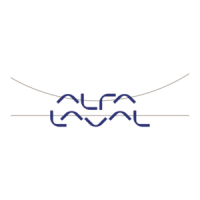
Do you have a question about the Alfa Laval PureBallast 3.0 Flow 1000 and is the answer not in the manual?
| Type | Ballast Water Treatment System |
|---|---|
| Flow Rate | 1000 m³/h |
| Treatment Method | Filtration + UV |
| UV Intensity | High |
| Ballast Water Treatment Standard | IMO D-2, USCG |
| System Type | Modular |
| Power Supply | 380-480 V, 50/60 Hz |
| Compliance | IMO and USCG |
| Treatment Technology | UV |
| Weight | Varies based on configuration |
| Dimensions (L x W x H) | Varies based on configuration |
Provides essential safety guidelines for operating, installing, and maintaining the PureBallast system.
Details safety precautions for maintenance, reactor modules, flow meters, valves, CIP, and ancillary components.
Details the process of pumping ballast water through the filter and AOT reactor for treatment.
Explains the process of discharging ballast water, bypassing the filter, and treating water for effectiveness.
Introduces the AOT reactor and its working principle, including UV light inactivation and radical generation for treatment.
Explains the function and components of the LDC, which provides power to the AOT reactor's UV lamps.
Describes the filter's working principle and components, highlighting its self-rinsing backflush operation for efficient filtration.
Details the CIP process for cleaning the AOT reactor and quartz sleeves, including the circulation of biodegradable solution.
Explains the function of the control cabinet as a central point for system monitoring, operation, and communication.
Offers detailed instructions for starting and performing a ballast process, including valve operations and pump control.
Guides the user through the steps for performing a deballast operation, including valve and pump control.
Instructs on how to respond to alarms and warnings, including identifying their status and taking corrective actions.
Provides procedures for safely stopping ongoing operations and deactivating the system, including using emergency stop buttons.
Lists all alarms and warnings related to the control system, lamp power supply, flow meter, and I/O modules.
Explains alarms triggered by and displayed on the LPS, including LED indications and possible causes.
Details alarms triggered by the flow transmitter, including fault-finding instructions and error lists.
Outlines a maintenance schedule sorted by component, referring to instructions for calibration and inspection.
Provides instructions for servicing the AOT reactor, including safety information, lamp replacement, and internal inspections.
Offers instructions for servicing the filter, including removing/mounting filter elements, replacing filter candles, and cleaning.
Details instructions for servicing the CIP module, focusing on changing and refilling CIP liquid and repairing the CIP pump.